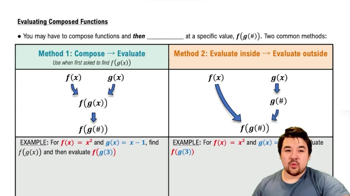Table of contents
- 0. Functions7h 52m
- Introduction to Functions16m
- Piecewise Functions10m
- Properties of Functions9m
- Common Functions1h 8m
- Transformations5m
- Combining Functions27m
- Exponent rules32m
- Exponential Functions28m
- Logarithmic Functions24m
- Properties of Logarithms34m
- Exponential & Logarithmic Equations35m
- Introduction to Trigonometric Functions38m
- Graphs of Trigonometric Functions44m
- Trigonometric Identities47m
- Inverse Trigonometric Functions48m
- 1. Limits and Continuity2h 2m
- 2. Intro to Derivatives1h 33m
- 3. Techniques of Differentiation3h 18m
- 4. Applications of Derivatives2h 38m
- 5. Graphical Applications of Derivatives6h 2m
- 6. Derivatives of Inverse, Exponential, & Logarithmic Functions2h 37m
- 7. Antiderivatives & Indefinite Integrals1h 26m
- 8. Definite Integrals4h 44m
- 9. Graphical Applications of Integrals2h 27m
- 10. Physics Applications of Integrals 2h 22m
2. Intro to Derivatives
Derivatives as Functions
Problem 3.1.56
Textbook Question
Find the function The following limits represent the slope of a curve y = f(x) at the point (a,f(a)). Determine a possible function f and number a; then calculate the limit.
(lim x🠂1) 3x²+4x-7 / x-1
 Verified step by step guidance
Verified step by step guidance1
Step 1: Recognize that the given limit represents the derivative of a function f(x) at a point x = a. The expression (lim x→1) (3x² + 4x - 7) / (x - 1) suggests that we are dealing with a derivative at x = 1.
Step 2: Identify the form of the limit. The expression (3x² + 4x - 7) / (x - 1) is in the form of a difference quotient, which is typically used to find the derivative of a function at a specific point.
Step 3: Assume that the function f(x) is a polynomial, since the numerator is a polynomial. A reasonable assumption is that f(x) = 3x² + 4x - 7, which is a quadratic function.
Step 4: To find the derivative f'(x), apply the power rule to each term of the polynomial: f'(x) = d/dx [3x²] + d/dx [4x] - d/dx [7].
Step 5: Evaluate the derivative at x = 1 to find the slope of the tangent line at that point. Substitute x = 1 into f'(x) to calculate the limit.
 Verified video answer for a similar problem:
Verified video answer for a similar problem:This video solution was recommended by our tutors as helpful for the problem above
Video duration:
5mPlay a video:
Was this helpful?
Key Concepts
Here are the essential concepts you must grasp in order to answer the question correctly.
Limits
Limits are fundamental in calculus, representing the value that a function approaches as the input approaches a certain point. In this context, the limit helps determine the slope of the curve at a specific point, which is essential for understanding the behavior of the function near that point.
Recommended video:

One-Sided Limits
Derivatives
The derivative of a function at a point gives the slope of the tangent line to the curve at that point. It is defined as the limit of the average rate of change of the function as the interval approaches zero. In this problem, calculating the limit will help us find the derivative of the function at the specified point.
Recommended video:

Derivatives
Function Evaluation
Function evaluation involves substituting a specific value into a function to find its output. In this case, we need to determine a function f and a point a, then evaluate the limit to find the slope at that point. This process is crucial for connecting the limit to the actual behavior of the function.
Recommended video:

Evaluating Composed Functions
Related Videos
Related Practice



